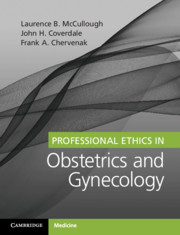Book contents
- Professional Ethics in Obstetrics and Gynecology
- Professional Ethics in Obstetrics and Gynecology
- Copyright page
- Dedication
- Contents
- Preface
- Acknowledgments
- Section 1 Professional Ethics in Obstetrics and Gynecology
- Section 2 Pedagogy of Professional Ethics in Obstetrics and Gynecology
- Section 3 Professionally Responsible Clinical Practice
- Chapter 7 Prevention of Pregnancy
- Chapter 8 Initiation of Pregnancy
- Chapter 9 Induced Abortion and Feticide
- Chapter 10 Fetal Analysis
- Chapter 11 Periviability
- Chapter 12 Intrapartum Management
- Chapter 13 The Perfect Baby
- Chapter 14 Cancer and Pregnancy
- Chapter 15 Setting Ethically Justified Limits on Life-Sustaining Treatment
- Section 4 Professionally Responsible Leadership
- Section 5 Professionally Responsible Innovation and Research
- Section 6 Professionally Responsible Health Policy and Advocacy
- Glossary of Key Concepts
- Index
- References
Chapter 11 - Periviability
from Section 3 - Professionally Responsible Clinical Practice
Published online by Cambridge University Press: 01 November 2019
- Professional Ethics in Obstetrics and Gynecology
- Professional Ethics in Obstetrics and Gynecology
- Copyright page
- Dedication
- Contents
- Preface
- Acknowledgments
- Section 1 Professional Ethics in Obstetrics and Gynecology
- Section 2 Pedagogy of Professional Ethics in Obstetrics and Gynecology
- Section 3 Professionally Responsible Clinical Practice
- Chapter 7 Prevention of Pregnancy
- Chapter 8 Initiation of Pregnancy
- Chapter 9 Induced Abortion and Feticide
- Chapter 10 Fetal Analysis
- Chapter 11 Periviability
- Chapter 12 Intrapartum Management
- Chapter 13 The Perfect Baby
- Chapter 14 Cancer and Pregnancy
- Chapter 15 Setting Ethically Justified Limits on Life-Sustaining Treatment
- Section 4 Professionally Responsible Leadership
- Section 5 Professionally Responsible Innovation and Research
- Section 6 Professionally Responsible Health Policy and Advocacy
- Glossary of Key Concepts
- Index
- References
Summary
This chapter provides an ethical framework to guide decision making about periviable birth.
Viability in professional ethics in obstetrics and gynecology is a function of both fetal physiology and available resuscitation and life-sustaining treatment. Viability is therefore the biological capacity of a live-born infant to survive even if full technological support is needed. This is the concept of viability used by the United States Supreme Court in its landmark ruling, Roe v. Wade, in 1973.
- Type
- Chapter
- Information
- Professional Ethics in Obstetrics and Gynecology , pp. 139 - 146Publisher: Cambridge University PressPrint publication year: 2019



